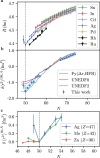Evidence of a sudden increase in the nuclear size of proton-rich silver-96
- PMID: 34321487
- PMCID: PMC8319127
- DOI: 10.1038/s41467-021-24888-x
Evidence of a sudden increase in the nuclear size of proton-rich silver-96
Abstract
Understanding the evolution of the nuclear charge radius is one of the long-standing challenges for nuclear theory. Recently, density functional theory calculations utilizing Fayans functionals have successfully reproduced the charge radii of a variety of exotic isotopes. However, difficulties in the isotope production have hindered testing these models in the immediate region of the nuclear chart below the heaviest self-conjugate doubly-magic nucleus 100Sn, where the near-equal number of protons (Z) and neutrons (N) lead to enhanced neutron-proton pairing. Here, we present an optical excursion into this region by crossing the N = 50 magic neutron number in the silver isotopic chain with the measurement of the charge radius of 96Ag (N = 49). The results provide a challenge for nuclear theory: calculations are unable to reproduce the pronounced discontinuity in the charge radii as one moves below N = 50. The technical advancements in this work open the N = Z region below 100Sn for further optical studies, which will lead to more comprehensive input for nuclear theory development.
© 2021. The Author(s).
Conflict of interest statement
The authors declare no competing interests.
Figures



References
-
- Warner DD, Bentley MA, Isacker PV. The role of isospin symmetry in collective nuclear structure. Nat. Phys. 2006;2:311–318. doi: 10.1038/nphys291. - DOI
-
- Batist L, et al. Isomerism in 96Ag and non-yrast levels in 96Pd and 95Rh, studied in β decay. Nucl. Phys. A. 2003;720:245–273. doi: 10.1016/S0375-9474(03)01093-5. - DOI
-
- Mărginean N, et al. Yrast isomers in 95Ag, 95Pd, and 94Pd. Phys. Rev. C. 2003;67:061301. doi: 10.1103/PhysRevC.67.061301. - DOI
-
- Lorusso G, et al. Half-lives of ground and isomeric states in 97Cd and the astrophysical origin of 96Ru. Phys. Lett. B. 2011;699:141–144. doi: 10.1016/j.physletb.2011.03.043. - DOI
LinkOut - more resources
Full Text Sources

